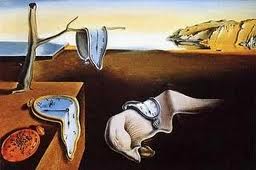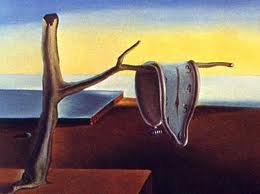La persistencia de la memoria
'La persistencia de la memoria' (The Persistence of Memory) was painted by the Surrealist Spanish painter, Salvador Dalí, in 1931. It is one of Dalí's most iconic paintings and is without doubt, one of his most famous.
The Painting

The painting was painted using oil paints on canvas and measures 24 centimetres by 33 centimetres. The painting is apparently based on a dream that Salvador Dalí had. The clocks represent the abnormal passing of time whilst one is dreaming.
The background of the painting is the bay at Port Lligat in Girona, the town where Dalí lived for some time and which now contains the 'Casa Museo Salvador Dalí' (Museum of the House of Salvador Dalí). The landscape is very simple, consisting in the sea and a small rock formation or cliff to the right hand side.
The foreground contains the famous melting watches and clocks. There are four clocks in total: a pocket watch in the bottom left hand corner and three soft, melting clocks which are draped on the tree, the strange figure in the centre of the painting and the box to the left hand side of the painting. Despite the clocks being deformed, they all continue to tell the time.
The third melting clock has a fly sat on the clock face whereas the pocket watch has a whole swarm of ants on it. Dalí often used these insects to symbolise death as well as the female genitalia.
Dawn Ades believed that Dalí had painted these deformed clocks as an unconscious representation of Einstein's Special Theory of Relativity of space and time. However when asked later, Salvador Dalí said that he had apparently been inspired to paint the melting clocks after witnessing some Camembert cheese melting in the sun, and that this was merely his Surrealist interpretation of that incident. However before Dalí painted 'La persistencia de la memoria', he also used the soft clock image in the painting 'Osificación prematura de una estación' (Premature Ossification of a Station) in 1930.
The figure or creature in the middle of the picture, over which one of the soft clocks is draped, appears to be fading. This relates to the dream-like paintings that many of the Surrealists painters liked to produced. The figure is not defined or clear, as it is often the case with dreams that you cannot picture the subjects of our dreams completely in our heads. The creature has a large eye with eyelashes which is shut, suggesting that the creature itself is also dreaming. Some people believe that this figure is actually meant to be a self-portrait of Dalí

This painting is clearly part of Dalí's Freudian period of painting as it is focused on the representation of dreams. Although it could be said that this was one of the starting points for his transition into the scientific period of his painting which occurred around 1945.
History
'La persistencia de la memoria' was first displayed at the Pierre Colle Gallery in Paris in 1931 before travelling to the USA a year later to be exhibited in New York in the Julian Levy Gallery. The painting was then bought by the Museum of Modern Art in New York for 400 US dollars in 1934 where it has remained ever since. The painting was loaned to the 'Teatro-Museo Dalí' (Dalí Theatre Museum) in Figuera, Gerona in 2009 for two months so that people could visit the Spanish painting in Spain.
After painting 'La persistencia de la memoria', Dalí returned to the same theme and created some copies and reworkings of the painting. For example, the painting entitled 'La desintegración de la persistencia de la memoria' (The Disintegration of the Persistence of Memory) from 1954 was a copy of the original painting but Dalí depicted it all in small pieces. Apparently this painting was inspired by the recent scientific advancements in particle physics and nuclear energy. The separation of the images also meant that further images could be found between the gaps. Dalí also produced a number of lithographs and sculptures on the same subject of melting clocks.
